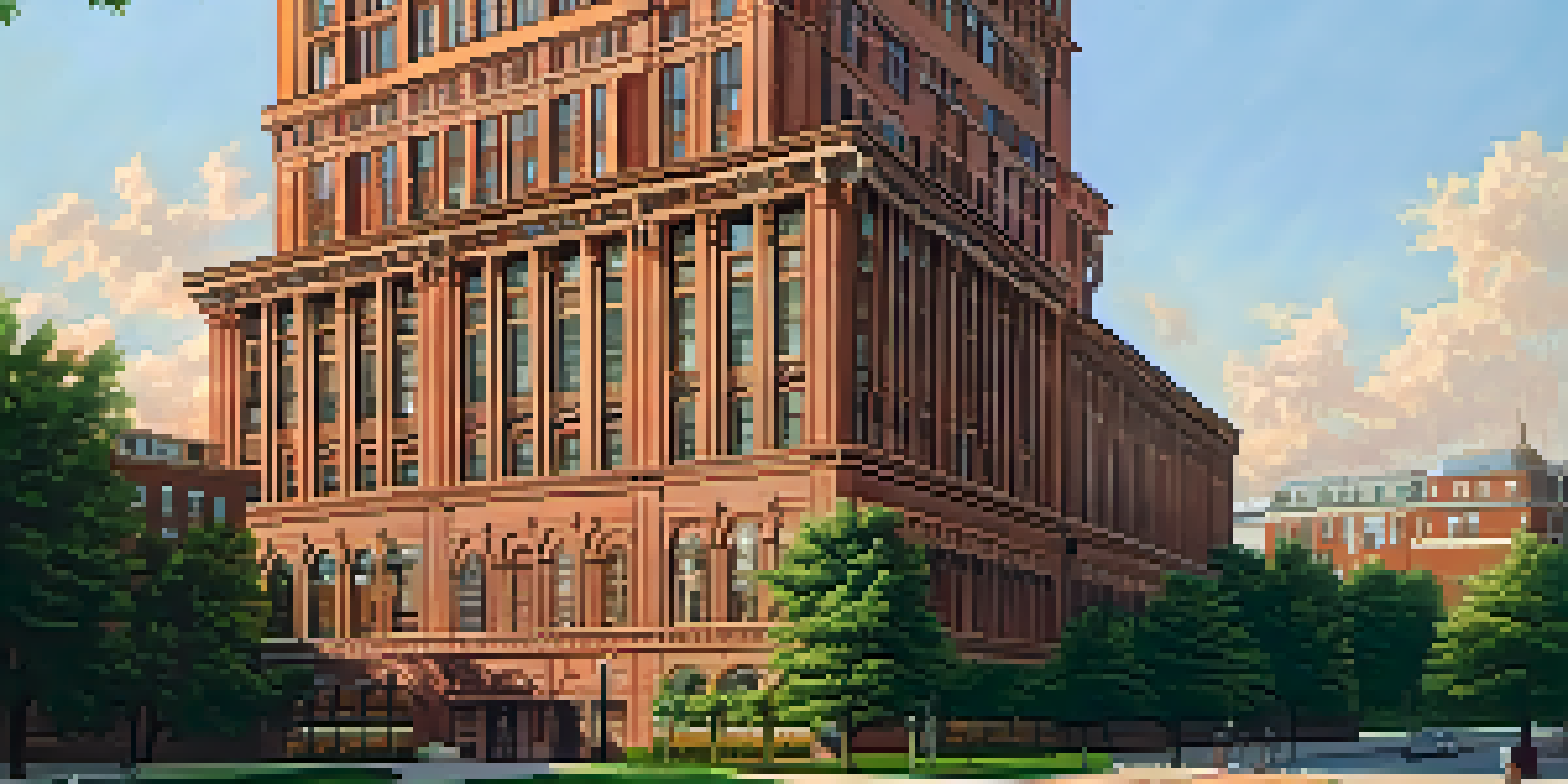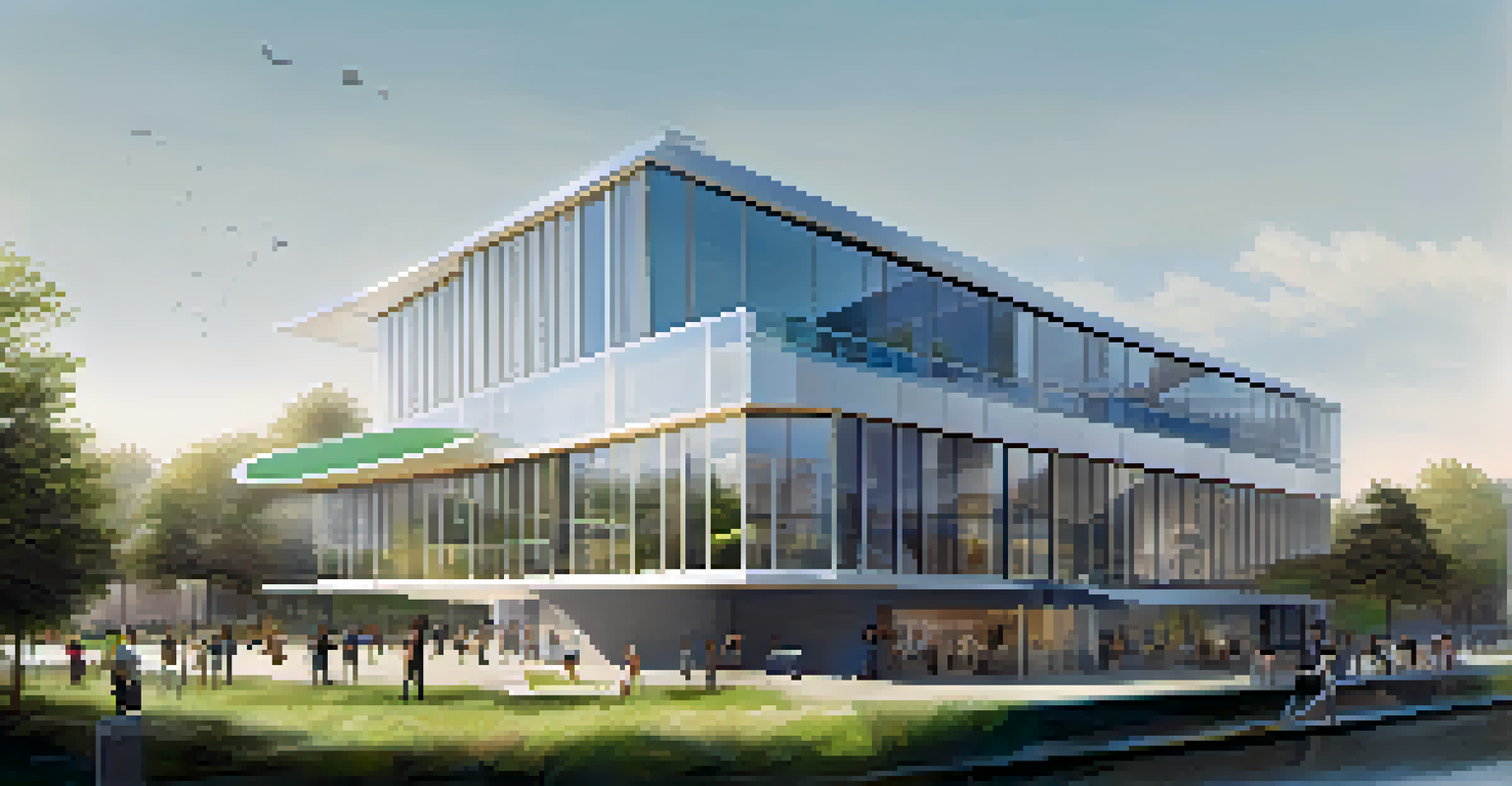The Influence of Louis Sullivan on St. Louis Architecture

Understanding Louis Sullivan's Architectural Philosophy
Louis Sullivan, often called the 'father of modern architecture,' believed in the principle of 'form follows function.' This means that a building's shape should reflect its intended purpose, rather than just being decorative. In essence, Sullivan aimed to create structures that were both functional and beautiful, a philosophy that resonates throughout his work.
Form ever follows function.
His approach was revolutionary for the time, as it shifted the focus from ornate, historical styles to a more pragmatic and innovative design. Sullivan's emphasis on simplicity and utility laid the groundwork for the modernist movement that would follow. This perspective not only changed how buildings were designed but also how they were perceived by the public.
In St. Louis, this architectural philosophy manifested in various structures that prioritized efficiency without sacrificing aesthetic appeal. Sullivan's work inspired architects to view buildings as living entities, capable of embodying both purpose and artistry, which is a sentiment still echoed in contemporary architecture.
Sullivan's Key Contributions to St. Louis Architecture
One of Sullivan's most notable contributions to St. Louis is the Wainwright Building, completed in 1891. This skyscraper is often regarded as one of the first true skyscrapers in the world, showcasing Sullivan's innovative use of steel and glass. The building's design emphasized vertical lines, which not only created a sense of height but also highlighted its structural integrity.

In addition to the Wainwright Building, Sullivan's work on the St. Louis World's Fair in 1904 showcased his ability to blend functionality with imaginative design. His contributions to the fair included several pavilions that captured the spirit of innovation and progress of the time. These structures demonstrated how architecture could inspire and engage the public in new ways.
Form Follows Function Principle
Louis Sullivan's principle of 'form follows function' emphasizes that a building's design should reflect its intended purpose rather than merely serve decorative purposes.
Sullivan's influence can be seen in the many buildings that followed, as architects in St. Louis and beyond began to adopt his principles. His vision encouraged a new generation to experiment with materials and forms, leading to a distinctive architectural identity for the city that continues to evolve today.
The Role of Ornamentation in Sullivan's Designs
While Sullivan advocated for functional design, he also believed in the importance of ornamentation. However, his approach to decoration was distinct; he viewed it as a means to enhance, rather than overshadow, the building’s purpose. His ornamental details often drew inspiration from nature, reflecting his belief that architecture should harmonize with the environment.
I am not a teacher, but an awakener.
A prime example of this is the intricate terra cotta work found on the Wainwright Building, which adds a layer of artistry without detracting from its functional design. Sullivan's use of organic motifs and geometric patterns brought a unique character to his buildings, allowing them to stand out in the urban landscape. This balance of form and ornamentation became a hallmark of his style.
By incorporating decorative elements that were both beautiful and meaningful, Sullivan set a precedent for future architects. His ability to blend ornamentation with functionality encouraged designers to explore new avenues of expression, ultimately enriching St. Louis's architectural narrative.
Sullivan's Impact on the Chicago School of Architecture
Louis Sullivan was a significant figure within the Chicago School of Architecture, which emerged in the late 19th century. This movement focused on steel-frame construction and was characterized by its innovative designs and urban skyscrapers. Sullivan's principles of design deeply influenced his contemporaries, including famous architects like Frank Lloyd Wright.
In St. Louis, the Chicago School's influence can be seen in the increasing number of tall buildings that emphasize verticality and structural innovation. Sullivan's mentorship and collaboration with other architects helped solidify these ideas, fostering a generation that valued both functionality and aesthetic beauty. His ideas transcended geographic boundaries, shaping skylines across the nation.
Impact on St. Louis Architecture
Sullivan's innovative designs, particularly in the Wainwright Building, helped shape a distinctive architectural identity in St. Louis that prioritizes both functionality and aesthetic appeal.
As a result, Sullivan's legacy is not just confined to his own work but extends to those who were inspired by his vision. The principles he championed in St. Louis and Chicago paved the way for modern architecture, illustrating the interconnectedness of the architectural community during this transformative period.
Sullivan's Legacy in Modern St. Louis Architecture
Today, Louis Sullivan's influence is still felt in St. Louis architecture, as contemporary designers continue to draw inspiration from his work. His emphasis on designing buildings that reflect their function is a principle that resonates with modern architects. This focus is evident in various new developments that prioritize sustainability and user experience.
Moreover, Sullivan's approach to ornamentation has evolved into a broader appreciation for local materials and cultural context in contemporary architecture. Many recent projects in St. Louis incorporate artistic elements that pay homage to the city’s history while embracing modern techniques. This blend of old and new speaks to the city’s unique architectural identity.
Through educational programs and preservation efforts, Sullivan's work remains a vital part of St. Louis's cultural narrative. As new generations of architects explore his principles, they contribute to a rich architectural dialogue that honors his legacy while forging new paths in design.
Preserving Louis Sullivan's Architectural Heritage
Preserving the works of Louis Sullivan is essential for maintaining the architectural heritage of St. Louis. Various organizations and local governments recognize the historical significance of his buildings and work tirelessly to ensure their conservation. This includes restoration projects aimed at reviving the original beauty and intent of Sullivan's designs.
One notable effort is the ongoing restoration of the Wainwright Building, which has undergone several renovations to preserve its unique features. Such initiatives not only protect Sullivan's legacy but also enhance the city's cultural landscape, providing residents and visitors with a glimpse into the past. The preservation of these structures serves as a reminder of the innovative spirit that defined Sullivan's work.
Legacy of Ornamentation
While advocating for functional design, Sullivan's unique approach to ornamentation harmonized beauty with purpose, influencing future architects to balance aesthetics with practicality.
By valuing and maintaining Sullivan's contributions, St. Louis can continue to celebrate its architectural history while inspiring future generations. The dialogue between the past and present enriches the city's identity, reminding us of the importance of history in shaping our built environment.
The Continuing Relevance of Sullivan's Ideas Today
As we navigate the complexities of modern urban design, Louis Sullivan's ideas remain relevant and influential. His thoughts on the relationship between form and function continue to inspire architects seeking to create spaces that are both practical and aesthetically pleasing. This relevance is particularly significant in an era that increasingly emphasizes sustainability and efficiency.
Furthermore, Sullivan's belief in the power of architecture to evoke emotional responses is echoed in contemporary design discussions. Architects today strive to create environments that foster community and connection, mirroring Sullivan's vision of buildings as integral parts of the urban fabric. His legacy encourages us to think critically about how our built environment affects our daily lives.

Ultimately, Louis Sullivan's contributions to architecture extend beyond his physical buildings; they invite us to reflect on the purpose and meaning of our surroundings. As cities continue to evolve, his principles offer valuable guidance for creating spaces that resonate with both functionality and beauty.